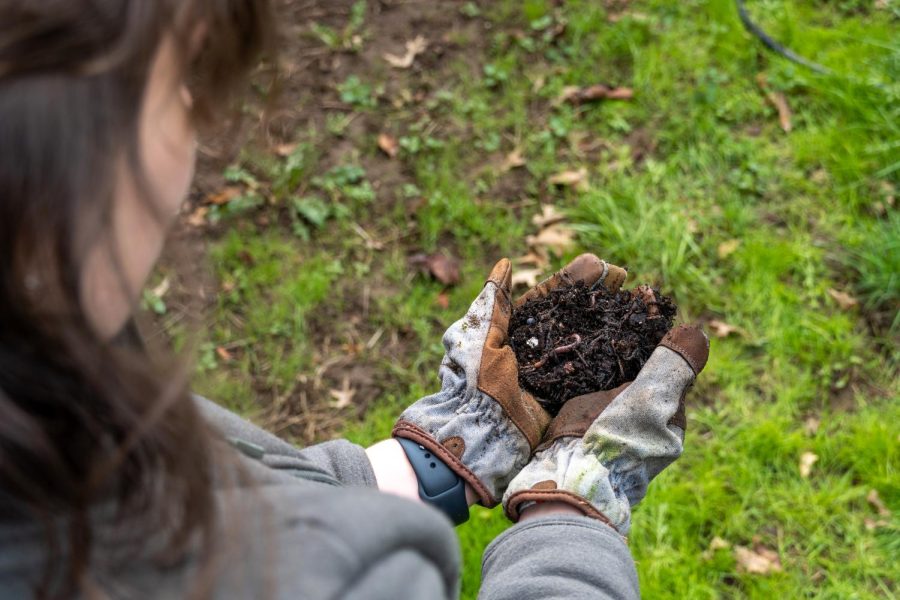How Corvallis residents turn food waste into fun
A photo illustration of someone holding compost in Corvallis, OR on Mar. 23rd. A great way to minimize your food waste could be by making compost.
April 10, 2023
Leftover spaghetti that you are throwing away is causing food waste — did you know that you could instead revive it by turning it into a pie?
Many may fail to realize that Americans waste about 25% of the food that they purchase. Not only that, the food waste is using 25% of our fresh water and wastes enough energy to power the country for over a week.
The United States Environmental Protection Agency’s Food Recovery hierarchy shows that the biggest impact that can be made to food waste is reducing it from the source.
The Food Waste Prevention Pilot Program at Oregon State University found that on campus residents waste about 1.3 lbs of food per student outside of dining halls every week.
During the Food Waste Prevention Pilot Program — a program that was dedicated to seeing how the amount of food waste in dining halls could be reduced — three strategies were tested to see if the program could reduce the amount of food waste. The program ended up reducing the amount of food waste from the participants by 51%.
The three strategies were: tracking food waste, having prompts to eat leftovers and signing a pledge.
Kaylee Smith, administrative program manager for Materials Management and a prominent researcher in the pilot program, said tracking food waste is the most effective tactic.
“On average, participants in the study reduced their waste by 51% over 4 weeks. This is likely due to greater mindfulness surrounding wasted food as the result of regularly tracking edible food waste,” Smith said.
Using prompts gave residents a constant reminder of why they should want to eat their leftovers.
These prompts include ideas ranging from money that could be saved, the environmental impact of food waste and social impact of not eating leftovers.
Residents signed a pledge and displayed a photo of themselves in the resident hall lounge. The objective of the pledge was to show that residents were making an effort to reduce food waste which caused more residents to want to do the same.
“When people see other people carrying out a behavior and you like the behavior you are more likely to follow out the behavior,” Smith said.
Another way that food waste can be saved is through composting.
“Compost contains essential plant nutrients. It improves soil structure. It retains water, decreases runoff and feeds beneficial soil organisms,” according to the Oregon State University Extensions website.
According to No Food Left Behind Corvallis, while composting is better than using a landfill, there are other alternatives that lead to better outcomes including feeding it to animals and donating excess food.
Reusing leftovers into new recipes is another way of reducing food waste. NFLBC has many recipes from locals in the community that can repurpose leftovers into a meal.
From turning leftover chicken into chicken with Indian spices, to turning leftover spaghetti into a pie, there are many different recipes that will reduce the amount of food waste you produce.
NFLBC is is a program of the Waste Watchers Team of the Corvallis Sustainability Coalition. According to their website, their “team was asked to develop this program in response to the mind-blowing statistics about the economic, environmental and social impacts of growing food that is never eaten.”
Their website has a myriad of ways for anyone interested to start watching their food waste. This includes a meal planner, shopping planner and a wasted food discovery form.



















































































![Newspaper clipping from February 25, 1970 in the Daily Barometer showing an article written by Bob Allen, past Barometer Editor. This article was written to spotlight both the student body’s lack of participation with student government at the time in conjunction with their class representatives response. [It’s important to note ASOSU was not structured identically to today’s standards, likely having a president on behalf of each class work together as one entity as opposed to one president representing all classes.]](https://dailybaro.orangemedianetwork.com/wp-content/uploads/2025/03/Screenshot-2025-03-12-1.00.42-PM-e1741811160853.png)























